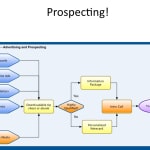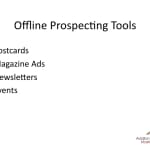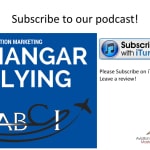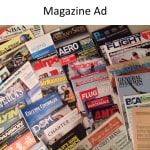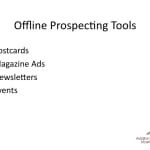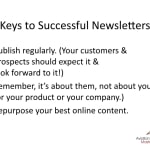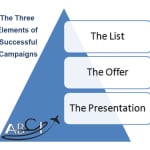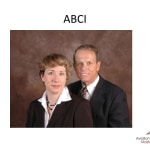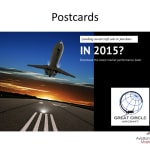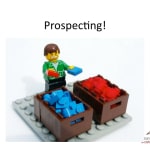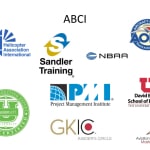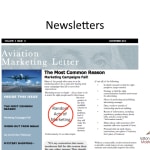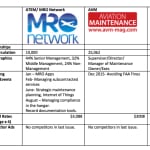 An Assumption- Blown to pieces . . .
An Assumption- Blown to pieces . . .
I came to the aviation Industry from the finance industry. When we started working with aviation companies in about 2009, my assumption:
If aviation sales and marketing professionals and business owners only knew how powerful and inexpensive digital marketing methods could be, they would drop everything, divert a lot of the crazy amounts of money they spend on magazine ads and trade shows, and gratefully and gleefully shower ABCI with contracts to execute digital campaigns.
Unfortunately, they didn’t quite see things our way.
At least, not in 2006.
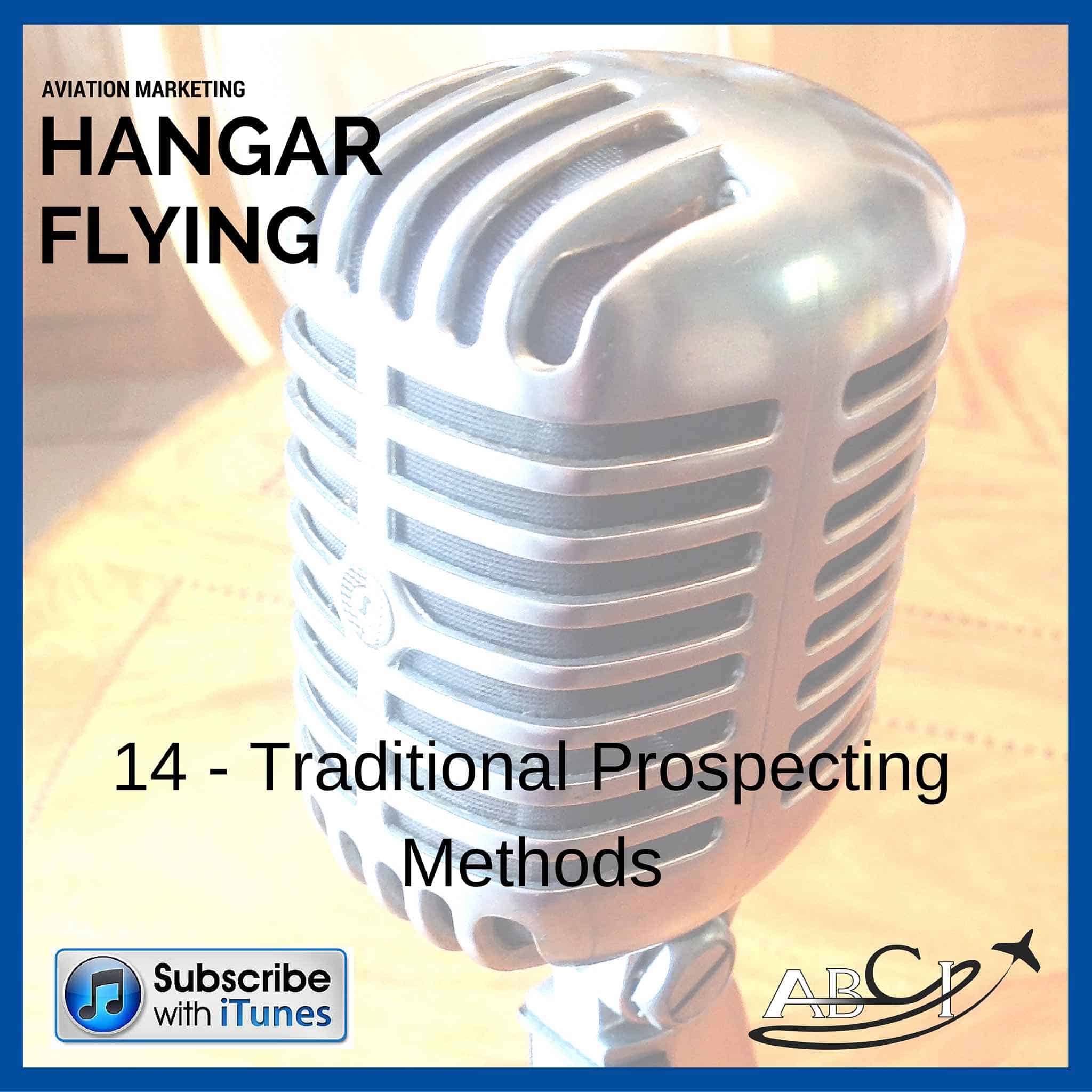 Since then, people have become much more accepting of digial marketing methods, but I have become MUCH more respectful of traditional methods, particularly the four we talk about in this podcast.
Since then, people have become much more accepting of digial marketing methods, but I have become MUCH more respectful of traditional methods, particularly the four we talk about in this podcast.
Aviation has some time-honored traditions that convey a certain prestige and credibility simply because of the format. Since the demographics of decisionmakers in the aviation industry are overwhelmingly demographically tradition-respecters, ignoring these methods can put your campaigns in peril.
John and I discuss four traditional prospecting methods in this podcast, including:
- Postcards
- Magazine Ads
- Newsletters
- Trade Shows
We go over pros, cons, and keys to success for each of these items, and how to include them in combination with others to make truly powerful and effective campaigns.
Transcript
Speaker 1 00:00:08 You’re listening to aviation marketing Hangar Flying. The community for the best sales and marketing professionals in the aviation industry. You can’t learn to fly just from a book. You learn from other pilots who know the tools, the skills and the territory. Your hosts, John and Paula Williams: are your sales and marketing test pilots.
They take the risks for you and share strategies. Relevant examples, hacks, and how tos. Be sure to subscribe on iTunes so you won’t miss a thing.
Paula Williams: 00:00:47 Welcome to aviation marketing Hangar Flying, episode number 14. Today we’re talking about traditional or off line prospecting tools. So I’m Paula Williams.
John Williams: 00:01:00 And I’m John Williams: , and it’s early in the morning.
Paula Williams: 00:01:03 [LAUGHTER] And we are ABCI. And ABCI’s mission is-
John Williams: 00:01:06 [LAUGHTER] To help you folks out there sell more products and services in the aviation world.
Paula Williams: 00:01:12 Absolutely. Right. So today, like I said, we’re talking about traditional or offline prospecting tools, things that existed before 2000, we’ll say.
[LAUGH] Some of the online things existed before then, but not in the form that they are in right now. So, if you’re interested in online tools, you can listen to Episode 13. But today, we’re going to go old school and talk about some things that have worked in the aviation industry for a really long time.
So we are members of a whole bunch of organizations and associations in aviation including MBAA. We’ve been asked to speak at aviation pros events and MBAA events, and Signus events, and lots of other things. So some of the things that we’re going to be talking about, as well as magazines.
We’re going to talk about printed news letters, we’re going to talk about postcards and yeah, so those four things, postcards, magazine adds, news letters and events. Which make up a pretty good composition of what used to exist prior to 2000, you think?
John Williams: 00:02:21 And an awful lot of it in print.
Paula Williams: 00:02:24 Exactly, so in print or in person is how things were done. Those are still the most credible places that people get their information in aviation, wouldn’t you agree?
John Williams: 00:02:36 Well I don’t know about getting their information but information with respect to purchasing.
Paula Williams: 00:02:42 Yeah, to make aviation purchases of products and services that they need for any aviation business.
John Williams: 00:02:48 A lot of research is done online still but I think when it comes to actual relevance to purchase other than basic research that’s on paper.
Paula Williams: 00:03:00 Exactly. So when your picking the methods that you wanna use for prospecting, you wanna look at the demographics of your ideal customer.
And in aviation that would be [LAUGH] somebody who is a lot like John, demographically.
John Williams: 00:03:17 Thanks.
Paula Williams: 00:03:18 [LAUGH] Well, I mean you’re looking for somebody who is male. Former military. Often, that’s a higher percentage than the average population. You’re looking for somebody who is a college graduate or has had some college.
You know, and all of those things. You’re looking for somebody who is pretty traditional type of guy. Wouldn’t you agree?
John Williams: 00:03:39 Whatever you say.
Paula Williams: 00:03:41 [LAUGH]
John Williams: 00:03:41 You’re the doctor here.
Paula Williams: 00:03:43 That is changing, we’re getting a little bit more diverse and a little bit more international. But if you sell a product or service, you can’t ignore their traditional demographic.
And those are folks who grew up with things like Controller Magazine, right?
John Williams: 00:03:59 Yes. As a matter of fact, that thing is still around.
Paula Williams: 00:04:02 Exactly, and some of the other things that you probably remember from years ago in the aviation industry, like postcards. They’ve been around forever.
John Williams: 00:04:15 Yeah. Now, and even the, although they’re trying to put the flight manuals electronically in boxes these days, they still have the paper versions as backup.
Paula Williams: 00:04:27 That’s true. So all of those things, print is still the most credible method. So what we do recommend when you put your prospecting plan together, is to have some online methods and some traditional methods, at least two of each is kind of what we’re recommending for 2016.
John Williams: 00:04:45 Okay.
Paula Williams: 00:04:46 Okay, all right so in the last few episodes we’ve talked about this story from Perry Marshall’s book and we’re going to come back to it, and that’s about racking the shotgun. Do you remember that story?
John Williams: 00:05:02 Yeah, you get people’s attention.
Paula Williams: 00:05:04 Exactly. So basically, there’s a particular sound that professional gamblers know very well, and that is the sound of racking a shotgun.
And if you walk into a casino and make that sound, there are some people, even if there’s a lot of noise and messiness in the room, there’s a lot of people who are going to look up because they recognize that sound. And those are the professional gamblers.
John Williams: 00:05:28 You sure that’s true today, I mean I’d look up.
[LAUGH]
Paula Williams: 00:05:32 Well I don’t know if that’s true today, but that’s the story and we’re sticking to it, right?
John Williams: 00:05:38 [LAUGH] Okay.
Paula Williams: 00:05:38 The point is what you wanna do is you want to get the intention of people who are the most likely buyers of your product or service, right?
John Williams: 00:05:45 Yep.
Paula Williams: 00:05:45 Okay, and every campaign, every advertising campaign has three elements, right?
John Williams: 00:05:55 Of course.
Paula Williams: 00:05:56 Which are?
John Williams: 00:05:58 They all start with the.
Paula Williams: 00:06:00 Right.
John Williams: 00:06:00 The list, the offer, and presentation.
Paula Williams: 00:06:02 The list, the offer, the presentation, exactly. So you want to have a list, an offer and a presentation.
That is really going to get the right people, that’s your list. You want to have an offer that is going to be really attractive to them, and you’re going to wanna present it in a way that really gets their attention and is credible to them. And the credibility is really where these offline tools come in.
So when you’re choosing offline offers, you wanna think about where does your list already hang out? What are the magazines they read? What are the events that they go to? What kinds of things catch their attention when they’re sorting through their mail or their garbage can?
John Williams: 00:06:42 Yes, as we said before, you don’t wanna put a billboard up on an old two rut trail where horses go.
You want it down a highway where all your fast high speed expensive cars go.
Paula Williams: 00:06:56 We’ve had talked about sorting people into two bins. [LAUGH] You have your buyers and you have your non-buyers or your ideal prospects and your non-ideal prospects. Now, if you were to advertise something and have a contest, let’s say, of the people that respond, you’re going to put them into a drawing for something.
I see this a lot in aviation, and it kinda makes me crazy. [LAUGH] So, let’s say you go to an event like a trade show, and everybody’s putting their business cards in a fishbowl for an iPad or something like that. Now the problem with that is it doesn’t help you sort your ideal buyers from your not ideal buyers, right?
John Williams: 00:07:38 Absolutely not, because anybody whoever thought they might have wanted an iPad that happens to be be at the show is going to drop off a business card to see if they win.
Paula Williams: 00:07:45 Exactly. Whether they’re interested in your product or service or not. So what you wanna do is think of an offer instead of that contest to win an iPad.
You want to think of something that only your ideal prospects are going to want and nobody else is going to. So you want a very specific bait, for a very specific animal if you wanna put it that way.
John Williams: 00:08:05 Yeah, preferably dealing with your product or service.
Paula Williams: 00:08:09 Exactly, okay so let’s start with the simplest of these things and that is post cards.
John Williams: 00:08:16 That’s simple.
Paula Williams: 00:08:17 Post cards are pretty simple. [LAUGH] They are a piece of card stock that is usually has an image on one side and an offer on the other.
John Williams: 00:08:26 Yeah but the design and production of said post card is not necessarily simple.
Paula Williams: 00:08:31 That is true.
So the best post cards that we have seen are ones that have a great list. Obviously you want to have a great group of people that you’re going to be sending these to, and we like to be super specific with those. So you can get lists these days, of pretty much anything.
And if you talk with someone at jet net or air pack, or any list broker, or with A V C I, we can help you find a list that is super specific, in terms of, geography in terms of what type of airplane do they have, how long have they had that airplane, what FAA ratings do they have.
All kinds of different things like that, that really help you zero in on your ideal customer.
John Williams: 00:09:16 Just about any Item of a demographic representation can be sorted and selected.
Paula Williams: 00:09:24 Um-hmm, for your postcard list. So then, you need to come up with a great offer for your postcard.
And that might be something along the lines of get a free report or a consultation on a problem that you know these people are having. So these are your customers, you should know them fairly well and you should know what keeps them up at night, right?
John Williams: 00:09:45 Right and unlike email you can send a postcard to anybody you gotta an address for and that’s legal.
Paula Williams: 00:09:51 Exactly, so also you kind of know what’s going on in their lives so If it’s coming up on tax season and you happen to be an aviation attorney that does taxes, you know what people, what questions people are going to have. So you could put together a nice little tip sheet about things that they need to know before they do their taxes for this year.
And make that the offer that shows up on your postcard, right?
John Williams: 00:10:22 Of course.
Paula Williams: 00:10:22 Okay, so if you got a postcard like that and you’re busily doing your taxes, you would download that for your report, right?
John Williams: 00:10:30 I would if I didn’t already have a tax attorney.
Paula Williams: 00:10:32 [LAUGH] Exactly, so. And even if you-.
John Williams: 00:10:36 Or I might even just keep him straight.
Paula Williams: 00:10:39 Yeah, even if you do have a tax attorney and this happens to be an area that you have an interest in. You might get a second opinion or you might look at it because of that.
John Williams: 00:10:50 Yeah, second opinions are always a good thing.
Paula Williams: 00:10:51 Right, so that headline on that post card needs to be something that’s going to get your attention, spark your interest and give you a reason to download this tip sheet and maybe give a second aviation attorney a call or give them your contact information.
Even though you are loyal and aviation people are nothing if not loyal to their current providers of services and their professionals that they work with.
John Williams: 00:11:22 Yep absolutely.
Paula Williams: 00:11:22 Okay so and that also is one of the biggest pros and cons of marketing and aviation is that aviation people are really, really creatures of habit.
It’s really hard to change their behaviour. And they have a group of people that they enjoy working with or that, at least haven’t done anything terrible. [LAUGHS] It’s really hard to get their business away from whoever is doing that service for them now. So what we like are postcards that have an arresting visual on one side, something that’s going to capture their attention and a great headline.
And we’ve done other programs about great headlines, so I’d recommend that you just look up headlines on our website and you’ll get some great tip sheets. How to write a great headline or how to go through your headline with a checklist to make sure that it’s doing everything that is should do.
On the other side of your postcard, you want that to be pretty detailed. You want to have some pretty good information about what they’re going to get and why they need it. So in the case of our example you’d have, here are some questions that you should ask before you do your taxes this year.
And here is a tip sheet that you can download and here’s where you go to get it.
John Williams: 00:12:38 The cool thing about postcards is even if you, as I, sort mail and throw crap out all the time, when you run across a postcard you at least pause long enough to look at it and it’s habit just to flip it over see what’s on the other side.
[LAUGH] So, you get it in front of your face whether you really want it there or not.
Paula Williams: 00:12:59 Exactly. One of the things I like most about postcards is because you all ready know I have a heavy preference in favor of online materials because you can deliver video and audio and lot of visuals and things like that very cheaply.
But what a postcard does is it kind a give you a hook that gets people into that online material. So you can give them a QR code, you can give them a link to go to, you can give them an 800 number, you can do a lot of things that take them from the physical world to the non-physical world and take them into your fabulous videos and audio and other material.
John Williams: 00:13:37 The cool thing to is even if they do can the post card it sticks in their brain.
Paula Williams: 00:13:42 Exactly. Okay so keys to successful postcards. One, you wanna get a great list. You can get it from Jetnet, Airpack. There’s a service with the US Postal Service that can do what they call Every Door Direct Mail, or EDDM, and you can get the most specific zip codes.
So you know those four digits that you put after the zip code? That goes to very, very specific neighborhoods and things like that. So if you only wanted people who are in a certain business park, as an example, who might be good charter clients for you. Or people who are very near your business or whatever the situation is.
John Williams: 00:14:24 Or have a specific
John Williams: 00:14:28 income level.
Paula Williams: 00:14:29 Exactly. Well that wouldn’t be EDDM but there’s other ways that you can do those kinds of break downs using a great list broker. The second thing you really need to do is make sure that that postcard is visually arresting for your target audience.
And we like to do a pretty big picture on at least one side of that postcard. Because big number one, the nice thing is it doesn’t come in an envelope. But hopefully they are opening their mail and your postcard has a 50 50 shot of coming up right side up.
And even if it doesn’t, they’re likely to turn it over before they throw it away. And if they do, you really wanna grab them by the eyelids [LAUGH] and say here’s something you really need to pay attention to. So you wanna have a great visual image or a very good photograph is often really effective.
You wanna have a great headline for your target audience. You wanna use keywords that they’re thinking about right now because of the time of year or because of their profession or because of what’s keeping them up at night.
John Williams: 00:15:35 And put a lot of time into that headline.
Because as we discussed before, writers will spend often more time on the headline, than they do on the article.
Paula Williams: 00:15:45 Exactly. Too often people just treat those headlines as afterthoughts. And they really are the most important thing, or the second most important thing on that postcard besides that visually arresting image that is going to get them to read your headline, right?
John Williams: 00:15:58 Mm-hm.
Paula Williams: 00:15:59 Okay and then you wanna have a great call to action. And we have a tip sheet that you can download from our website. Speaking of such things that has 17 great calls to action, ideas for great calls to action that you can download. So if you don’t all ready have that, go ahead and download it and then you’ll have some ideas of things that you can do for a great call to action.
Okay, so that’s postcards. Let’s talk about magazine ads. You probably liked magazine ads from the beginning of time, most of us have, right?
John Williams: 00:16:34 Yeah, still use them actually.
Paula Williams: 00:16:37 Even though a lot of magazines are online nowadays, we still get a lot of them in the mail cuz we subscribe to a lot of them, right?
John Williams: 00:16:44 Yes and I am one of those characters that prefers paper in hand than to read leisurely on a screen.
Paula Williams: 00:16:54 Exactly, so these are things you can read on the couch, in between meetings, whatever. You can relax with and in a lot of cases, the demographics that we’re looking at are people that read paper magazines.
So you don’t wanna exclude those from your marketing plan, even though you may also be running banner ads. And one thing that we’ve seen lately is that people will do these combination deals. The magazines want to give you if you want a printed ad that’ll also give you an online ad as well.
So, you can work a pretty good deal when you want those print ads to get some online marketing as well. But to compare, apples to apples, what we like to do is create a grid or a matrix. Where we put all of the magazines that we think our ideal customers subscribing to.
And in this case, we took four of them, this is would be for aviation technicians, MRO network aviation maintenance, DOM magazine and AMT. And so we put those four in the columns and then we had different rows. And the rows that we have are things like relationships. Do we have relationships with people in the magazine or do we already have ads running in that magazine?
The second row would be print circulation. How big of an audience does that magazine have? And these are the things you can find out from their rate card, which they provide to advertisers and you can download it, or your advertising sales person would be happy to send you a copy, right?
John Williams: 00:18:32 Of course, since they want your business.
Paula Williams: 00:18:34 Exactly, so we want to know what is their print circulation for this purpose. We wanna know the demographics of that print circulation. How many of them are in different positions and other kinds of things. We want to know what are the upcoming topics and events that they are planning to cover.
So if they’re planning to cover a topic that is near and dear to our hearts because of the item that we’re selling, that would be an issue that we definitely wanna be featured in, if that’s relevant to us. If somebody’s already picked up that magazine for that article, we wanna be close to that article, right?
John Williams: 00:19:12 Absolutely.
Paula Williams: 00:19:13 Right and of course, we wanna know the rate. So how much is it going to cost for let’s say a quarter sheet ad and we wanna rent it four times. And why do we say a quarter sheet ad and we wanna rent it four times as opposed to one big splashy full page ad that we run once?
John Williams: 00:19:32 If you have one big splashy full page ad you don’t wanna run it once.
Paula Williams: 00:19:37 [LAUGH] You never really wanna run anything once unless its for a particular event or something like that. You don’t wanna look like a flash in the pan especially to an aviation audience.
You really wanna look like a consistent credible entity that’s doing business over the long haul and looking to build relationships. So we’d really rather have people advertise in every issue or every other issue even if that means having a smaller ad, than having one big splashy ad that just appears once and then disappears.
John Williams: 00:20:10 Now, you do wanna use this big splashy ad for some thing that happens once in a life, your company, or once every couple of years. And do that and you plan on which month you really wanna do that in. But keep on going a quarter sheet stuff.
Paula Williams: 00:20:24 Exactly, yeah, so you only wanted, and even then you only wanna advertise in magazines that you’ve already been advertising in.
John Williams: 00:20:31 Right.
Paula Williams: 00:20:32 Cuz there are two times that people pay the most attention to magazine ads, and one is when they start running. And the other-
John Williams: 00:20:39 Is when they quit.
Paula Williams: 00:20:39 Is when they stop running. So whenever you started doing an advertisement in a print magazine, you wanna make sure that’s something that you’re committed to for the long haul. Because people will notice when you stop running that ad as well. And that will do you almost as much harm, as it will do good.
Okay, so keys to successful magazine ads. One, you wanna choose the right publication, right?
John Williams: 00:21:07 Absolutely, it’s the billboard thing.
Paula Williams: 00:21:10 Yup, you wanna put it right in the way of your ideal customer. So, and that doesn’t necessarily mean that the magazine has to be about the topic that your product is about.
In fact, there was one example that we ran across in a marketing group that we’re in, where it was an aviation product that they were advertising in a golf magazine. And the reason is because they looked at the demographics and found out that a lot of their ideal customers subscribed to this golf magazine.
And of course, they were the only aviation ad in this golf magazine. And it’s better to show up alone. So the most important thing is do your prospects read it, not is the topic aligned with my product.
John Williams: 00:21:57 As an aside, works for trade shows, too. If you’ve been to NDAA and seen the guys that are selling yachts.
Paula Williams: 00:22:03 Mm-hm, exactly, so be in the right place whether or not the topic is correct. And of course, we talked about the opposite of that. If there is a topic that is exactly correct, that’s another opportunity for you. If they’re writing a buyer’s guide to tax attorneys, you wanna be [LAUGH], have your ad right next to that article if you possibly can.
So, choose the right publication. Second, again you wanna be visually arresting. So in some cases, you can do that with text. So if all of the rest of the ads in this magazine are all big beautiful pictures of airplanes, then the last thing that you wanna do is be a big beautiful picture of an airplane.
You wanna stick out, you wanna be visually arresting. Not necessarily visually beautiful, right?
John Williams: 00:22:52 True.
Paula Williams: 00:22:53 Okay, beautiful is good, but getting attention and making the point is better. You wanna have a great headline just like you did with the postcards, same rules apply and you wanna have an irresistible call to action.
So you’re spending money on these ads, you wanna make sure that you’re spending a lot of time going over that headline and that call to action. And if you’re in the master class you wanna take that ad and stick it out in the news feed or in the private Facebook group, and get some eyes on that thing before you pay money to have it in your magazine.
John Williams: 00:23:32 You need to think, well back in the day. You used to be able to pay more money to have the ad on the front page, the back of the front page, the front of the back page, or the back of the back page, or in the middle or various places in it.
Is that still true?
Paula Williams: 00:23:46 That is still true, yup.
John Williams: 00:23:47 So you’ve gotta think about where in the magazine you want your ad as well.
Paula Williams: 00:23:53 Yeah, the placement is very important. And again, that could be, some options you have are placing it by or not by other ads.
You may want to be right next to your competition or far away from your competition, depending on how you’re playing that strategy. You wanna be next to or far away from certain features in that magazine. If there’s a cartoon or something that’s really popular, and you know everybody’s going to go straight to that, you wanna be next to that.
Inside the front cover and inside the back cover, those are always good placements because people tend to flip there first, right?
John Williams: 00:24:30 Right, and I said the front page, I meant the front cover.
Paula Williams: 00:24:33 Right, exactly.
John Williams: 00:24:35 Or the back cover.
Paula Williams: 00:24:37 Mm-hm. And sometimes that has to do with places that you can get good deals on color, so somethings like controller magazine that are not necessarily color, all the way through.
You need to think that through as well. Your ad salesperson will be happy to explain the mechanics to you, but it’s best if you go in with those four things figured out. The right publication, visually arresting, great headline, irresistible call to action.
John Williams: 00:25:04 Absolutely.
Paula Williams: 00:25:05 Absolutely. Okay. So let’s talk about print newsletters.
We had gone the rounds with this and I know it’s a huge amount of work. It’s a huge commitment in time and money. To send a printed newsletter. But we have cut back on them, and we have decided not to cut back on them, because of the results on our business, right?
John Williams: 00:25:28 As a matter of fact.
Paula Williams: 00:25:30 Right. So the nature of aviation is that we have a long sales cycle and that we know that this demographic takes printed materials to be more credible than online materials. So those two things add up to the fact that we just have to invest the time and money, as much as we would rather not, doing a printed newsletter.
And the odd thing is we put the same stuff in our printed newsletter that we have had on our blog. And actually it comes out on our website probably anywhere from three to six weeks before it ends up in the printed newsletter, just because that’s the way our work flow works.
But we get a lot more attention to that same material when it’s sent in a printed newsletter than we have on our website.
John Williams: 00:26:21 And what’s interesting is, [COUGH] excuse me. We send these things out to our list, and on rare occasions when somebody doesn’t get one, we’ve had calls saying where’s my newsletter?
Paula Williams: 00:26:38 [LAUGH]
John Williams: 00:26:38 And they’re not even paying for it.
Paula Williams: 00:26:40 Exactly. So when people start complaining when they don’t get it, then you know you’re on to something good. But the other thing is, and we’re talking about prospecting methods here, so newsletters are also a great way to work on your face, too, which is building credibility, and closing, and getting people more information about your product and service.
But on the very front end, we like to send prospecting packages which include a newsletter. And what that says to somebody who gets that for the first time is this company has committed. They have resources. They really wanna build relationships with people. They really wanna educate their customers.
They’re going to a lot of effort and expense to do all of those things. You know this is not a fly by night company this is somebody that has a workflow that can accommodate getting this [LAUGH] enormous piece of work out the door once a month or once a quarter or whatever your frequency is right?
John Williams: 00:27:38 Yes and it is quite the task.
Paula Williams: 00:27:41 It is quite the task. Yeah, we don’t want to lie about that. But there are ways to make it easier. For our clients, we do their newsletter for them. So we take existing materials we just format it, put it together.
All they have to do is look at it and approve it so it’s not that big of a task for them [LAUGH]. But it is kind of an expense because we do, there is the printing and the postage so that’s something that a lot of our clients, until they see how newsletters work, there is usually a little bit of resistance to that going, the same material is already out there.
But again, it is just a much larger impact and if you’ve already invested in great articles and cartoons and visuals and other good stuff, you wanna put it in front of people in the way they’re going to accept the most readily.
John Williams: 00:28:29 And hopefully you’ve been building a house list.
Paula Williams: 00:28:31 Absolutely. Okay, so this also gives your salespeople another opportunity to give people a call back and say there’s an article in the newsletter that I wanted to draw your attention to because it applies to your situation. So, that makes them sound really educated rather than sounding really salesy, right?
Okay. So keys to a successful newsletter. There’s only three this time so this one’s easier to remember. One, you wanna publish regularly. Your customers and prospects should expect it and look forward to it.
John Williams: 00:29:07 As they do when they call us and say they didn’t get it.
Paula Williams: 00:29:10 [LAUGH] Right okay and then number two you ought to remember that it’s about them, not about you.
It’s not even about your product or your company. It’s about your customers. What are they going to want to read? A great example that one of the guys in our marketing group talked about, he did a newsletter for a dry cleaning company and the first one that he did was all about different processes of dry cleaning.
And why one is better than the other. But you know what? People really don’t care [LAUGH]. They just want to get their clothes clean. So you change that to things like fashion tips, what’s coming up this year, and why fur is going to be controversial or not controversial.
All of those kinds of things. Different ways to dress to impress, and stuff like that, so those are things that his readers really want to read. And they’re not as relevant to dry cleaning as just simply having a dry process versus wet process of removing a stain. Nobody cares about that, right?
John Williams: 00:30:14 Exactly, as long as it works.
Paula Williams: 00:30:16 Yeah, so most people make the mistake of going way too technical and way too nerdy with their newsletter. And we’ve done that as well. So, you really want to make sure that it’s about your customers and the things that they want to read.
Not necessarily about your product or your company. And a third key to success with a newsletter is to repurpose your best content. So take the stuff that’s getting the most traffic on your website and get even more leverage out of that by investing in getting that printed up and sent out to people.
Right?
John Williams: 00:30:52 Yes.
Paula Williams: 00:30:52 Yes, okay cool. So events, we’re getting close to done, it’s early in the morning when we’re recording this already, alluded to that fact so, events can be bewildering and crazy and expensive and all of those things. But they can also be a really great way to get new customers.
So we don’t attend a whole lot of events. We usually do four or less per year because when we do them we wanna do them really really well.
John Williams: 00:31:21 Yeah they’re an expense, and not just in dollars, but time out of your business.
Paula Williams: 00:31:29 Exactly, so. Basically we have an entire checklist as our trade show marketing checklist that you can download from our website and that’s at aviationbusinessconsultants.com/tradeshows.
You can just go to that address and fill out the little form and download that. Its like a 20 page checklist of things that you should be doing 120 days before, 90 days before, 60 days before, 30 days before. As well as after, 7 days after, 30 days after the trade show.
But if you’re going to invest in a trade show, and these things can be It’s not unusual for aviation companies to spend tens of thousands or even a quarter of a million or more on a great trade show appearance.
John Williams: 00:32:15 I mean, even our first trade show, we spent in excess of $10,000.
And we were trying to [LAUGH] not spend a lot of money.
Paula Williams: 00:32:23 Yeah, and that was when we were bootstrapping our business. So it was a crazy amount of money for us at the time. But we felt like we needed to be there, because we needed to have the credibility of being able to say we’ve exhibited at MBAA, which was the biggest trade show in the world, I think, for aviation.
John Williams: 00:32:43 Well, at least in the free world it still is.
Paula Williams: 00:32:45 Yeah, so in some cases it is worth the investment but you definitely want to put the time and energy and work into preparing for that and making sure that you’ve got a plan. Going in, you’ve done your homework, you’ve got your top ten most wanted customers figured out, you’ve got an approach for those top ten most wanted customers.
You can do public speaking at these things, you can do press releases about your product. They’re just riddled with opportunities to do publicity. And then we are just absolutely astonished at the number of people that go to events, and sit in their booth, and then go home, without doing enough preparation or follow up to make that worth the money.
John Williams: 00:33:25 Yeah, you’ve seen them, the guys or girls sitting there with their head in their tablet, or their phone, or their iPad, or reading a book, and people walking by and nobody is saying anything.
Paula Williams: 00:33:35 Exactly. So yeah, there’s a lot to trade shows and we’re not going to get it all done here.
[LAUGH] But we do recommend that you go download that checklist which goes into a quite a bit of detail about how to make a trade show successful because that is such a huge investment and-
John Williams: 00:33:53 Time and money.
Paula Williams: 00:33:53 Time and money. And when we talk with a new client, that’s one of this first things we talk about is their trade show schedule.
Are the trade shows that they’re going to the right ones, and are they going to too many so that they can’t prepare for and follow up from them successfully? Or are they spending too much of their marketing budget on trade shows without enough of a return investment?
John Williams: 00:34:15 Yeah, and then in a few cases, the fact that they’re not going at all.
Or hadn’t planned to.
Paula Williams: 00:34:20 Exactly, right. So, for us the right number is four or less. For some companies it may be every single month. Trade shows may be their most important prospecting activity. And, if that’s the case, then you turn your company into a trade show machine.
And, a lot of companies do that very successfully. In fact, there was one company that we worked for that had two separate trade show booth setups, so one would be coming and one would be going. So they ship one to the next show while the other one was being taken down and shipped back to the company from the last trade show.
But they were one that did every single month. So yeah, download that checklist and that will tell you all about trade shows. So offline prospecting tools, we talked about postcards, magazine ads, newsletters and events, right?
John Williams: 00:35:15 Every one.
Paula Williams: 00:35:17 Every one. Right. So get that tip sheet, which is calls to action.
You go to aviationbusinessconsultants.com/ctas, we’ve made a slightly easier URL for you so that you can find that at, once again, aviationbusinessconsultants.com/ctas. We also have another tip sheet at aviationbusinessconsultants.com/tradeshows where you can get that trade show checklist. And all of these are linked, of course, from this podcast show notes page.
So we’ll make that easy for you to get that information. All right. So be sure to subscribe to our podcast on iTunes and leave a review. And also, if you are listening to this podcast, and I know this may not be the right timing for you, but if you have not yet registered for our master class, and it’s still January.
We are doing buddy passes this month, which is really cool because you can get somebody from your company to join with you for the same amount of money. So, a silver membership is $279, which is the best kept secret as far as bargains when it comes to consulting time, when it comes to networking, when it comes to getting great advice for your marketing programs and things like that.
And being part of a group of really supportive helpful people, right?
John Williams: 00:36:41 And that was $279 per month right?
Paula Williams: 00:36:45 $279 per month and you can bring someone with you, so you both become full members. We send you both copies of all of our materials. You both get logins so you can login and participate in our events.
You both get invited to our Facebook private group, talk about things, and you’re able to float those magazine ads and things before you spend a lot of money on them. And again, we think that’s really the best investment that you can make, try to make this everything that you need, that we can possibly cram into a very small price.
So, you do have to be at the same postal address to take advantage of that deal because we do put them both in the same packaging so that we can save a little bit of money. But you both get to be members for as long as you guys stay members.
It’s just that one price, $279.
John Williams: 00:37:34 Sounds like a deal to me.
Paula Williams: 00:37:37 Right, absolutely. So subscribe to our podcast on iTunes, and please do leave a review. Again, this is kind of a new podcast. This is only episode 14, so we’re still in our infancy, and we still need as much help as we can get.
So do leave us a review, let us know how we’re doing. Let us know what you’d like to see more and less of, and we’ll do our best to accommodate.
John Williams: 00:37:57 And we’ll see you next time.
[MUSIC]
Speaker 1 00:37:59 Thanks for joining us for aviation marketing Hangar Flying, the best place to learn what really works in sales and marketing in the aviation industry. Remember to subscribe on iTunes and leave a rating.
[MUSIC]
More Articles about Aviation Prospecting
Understanding Prospecting in the Aviation Marketing Life Cycle
AMHF 0011 – Advertising and Prospecting Basics
AMHF 0012 – Prospecting, Calls to Action & Lead Magnets
AMHF 0013 – 6 Prospecting Methods Using Aviation Digital Marketing
AMHF 0014 – Four Traditional Prospecting Methods
AMHF 0049 – How to Use LinkedIn for Prospecting in Aviation
AMHF 0050 – Power Prospecting – Aviation Marketing Book Club Discussion
Eight-Step, Never Fail Aviation Prospecting Method
This course was adapted from our Podcast, and enhanced with templates and worksheets. We’re offering it free for a limited time.
Why did we build this eight-step, fifteen-day prospecting campaign?
Because you have leads. (Or at least partial leads) But what you really need to sell more products and services is to book consultations.
We built this process from four sources:
Our own practice (hence the examples!)
Predictable Prospecting – How to Radically Increase Your B2B Pipeline by Marylou Tyler and Jeremy Donovan
Magnetic Marketing by Dan S. Kennedy
Email It! A Sellers Guide to Emails that Work by Bill Caskey
..


